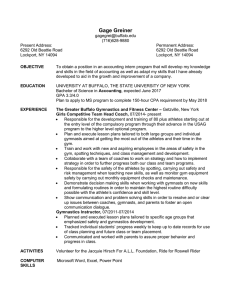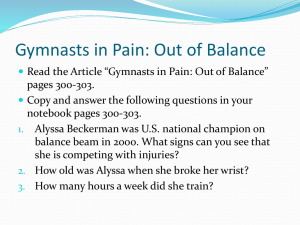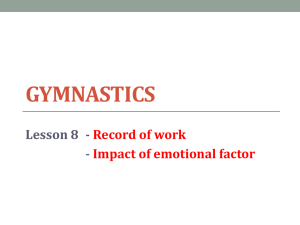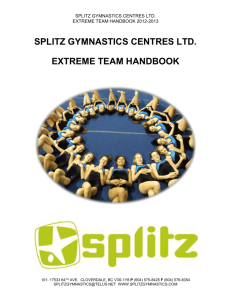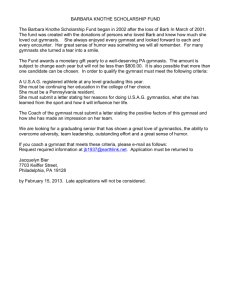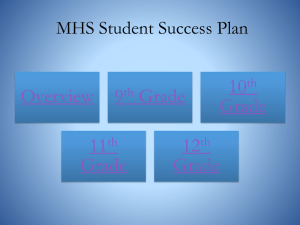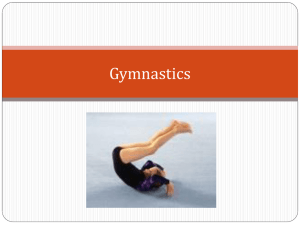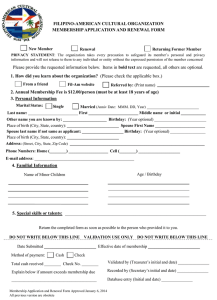Gymastics (Artistic) - Special Olympics Michigan
advertisement
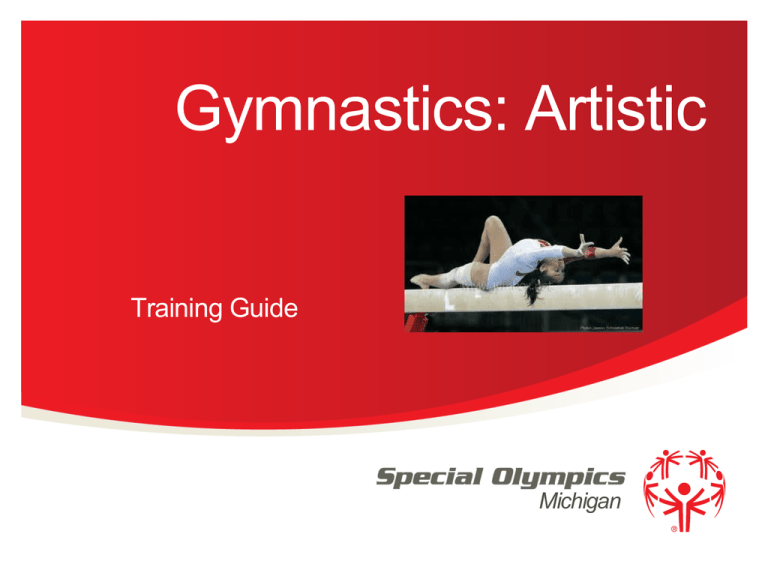
Gymnastics: Artistic Training Guide Michigan Events Offered Women’s Events • Vaulting • Level I, II, III & Optional level IV • Uneven Bar • Level I, II, III & Optional level IV • Balance Beam • Level I, II, III & Optional level IV • Floor Exercise • Level I, II, III & Optional level IV • All Around • Level I, II, III & Optional level IV 2 Special Olympics Michigan Events Offered Men’s Events • Floor Exercise • Level I, II, III & Optional level IV • Pommel Horse • Level I, II, III & Optional level IV • Vaulting • Level I, II, III & Optional level IV • Parallel Bars • Level I, II, III & Optional level IV • All around • Level I, II, III & Optional level IV 3 Special Olympics Michigan Events Offered Level A (Male and Female) • Tumbling • Vaulting • Floor Exercise • All around 4 Special Olympics Michigan Uniform Regulations (male) • Preferred Uniform: For male gymnasts, the preferred uniform is a tank top (leotard) and long manufactured gymnastics pants or shorts. A T-shirt that is tucked in may replace the tank top. Gymnasts may compete in white socks, gymnastics slippers, or bare feet. Starting numbers may be required for technical and organizational purposes. Uniform Regulations (female) • Preferred Uniform: For female gymnasts, the preferred uniform is a long-sleeve manufactured gymnastics leotard with bare legs. Gymnasts may compete in bare feet or gymnastics slippers. Flesh-colored tights with bare feet are permitted, but not recommended. Sleeveless leotards may be worn if temperature or body type warrants it. Bandages may be worn as long as they are secured fastened. Hip padding is not permitted. The only jewelry allowed are stud earrings. Starting numbers may be required for technical and organizational purposes. Competition Levels • Athletes may enter all 4 events in the same level and compete for the all around awards, or be a specialist competing in 1, 2 or more events in the same level. • There are five separate levels of competition: ‣ Level A – Developmental Athletes only (Mixed Gender) ‣ Level I – Beginner Compulsory ‣ Level II – Intermediate Compulsory ‣ Level III – Advanced Compulsory ‣ Level IV – Advanced Optional General Rules • Athletes who compete in artistic gymnastics may not compete in rhythmic gymnastics in the same competition. • Level IV gymnasts perform an optional routine. • In all-around competition, athletes must compete at the same level in all events. • Atlantoaxial Instability Rule: Athletes with Down Syndrome must have an x-ray indicating that he/she does not have atlantoaxial instability prior to participation in any gymnastics event. General Rules • Each floor exercise will have a designated song and routine for each level. • Each score has a maximum of ten points possible to earn and each event has its own set of point deductions in the training packet. • In the training packet there is a designated routine for male and female performances on each event and level of event. Age Regualtions • Age Group Divisions: 8-11, 12-15, 16-21, 22-29, and 30+. Schedules are sometimes presented as junior (8-15) and senior (16+). • Age groups may be combined if there are not a sufficient number of athletes to have a competitive division. Be Aware… • Modifications: Athletes with hearing or visual impairments are allowed cues and signals from the coach. Coaches must notify the meet director and judges of the athlete’s impairment before the event begins. Possible deductions Neutral deductions are taken off the final score. There is a four point maximum to these deductions. Examples include: 1) Improper attire 0.3 each routine 2) Improper equipment and use of aids 0.8 each routine (Coach may petition in case of special needs) 3) Undisciplined or unsportsmanlike behavior 0.3 each time 4) Failure to present to judge before or after 0.3 each time 5) Failure to remove board or mounting surface 0.3 each time 6) Coaching assistance (Special Olympics Modifications:) a) Physical assistance 0.5 each time b) Verbal assistance 0.3 each time c) Signals to gymnast 0.2 each time 7) Not starting within 30 seconds of judges’ signal 0.3 each time 8) Not wearing competition number (if provided) 0.3 each time Good to know.. • Gymnastics is primarily an anaerobic sport -- or a sport that utilizes energy without oxygen. As a result, strength and power are essential components to the strength training of gymnastic conditioning. The goal of the anaerobic strengthtraining workouts is to increase maximum strength without sacrificing the flexibility and mobility of the muscles and joints by significantly increasing muscle size. • Learning new skills and fundamentals must be preceded by building a sufficient amount of strength. The strength level ensures that the skill and fundamentals are learned correctly the first time. Without sufficient strength, it will be nearly impossible to execute the fundamentals correctly, or the skill will need to be relearned as strength levels improve. • With the specific demands of gymnastics fundamentals, the strength-training exercises must be sport-specific. These sport-specific exercises resemble the movement patterns used during a gymnastics competition. Sample strengthtraining exercises include pull-ups, pushups, handstand pushups, situps, lunges and squats. The specific exercises help to build functional strength essential for learning new skills. Flexibility ‣ Flexibility is a key skill for gymnastic events. By improving your flexibility, you expand your range of motion, making it easier to maintain correct form while reducing the risk of injury. Flexibility can also improve body awareness and relaxation of the muscles, which can also improve a gymnast's performance. As preparation for a workout, practice dynamic stretching, which uses movement to reduce the tightness of the muscles. Examples include lunges and arm circles. For general work on your range of motion, opt instead for PNF, or proprioceptive muscular facilitation, stretches. For a PNF stretch, first hold a passive stretch, using an external aid for support. For example, lie with one leg straight on the ground and the other elevated as close to vertical as possible. Have a partner gently press your extended leg toward vertical to the point of mild discomfort. Next, contract your hamstrings, pushing slightly further against your partner's hand. Finally, relax the hamstring muscles and let the partner do another short passive stretch. Strength Training • Before beginning a new strength-training routine, consult with your gymnastics coach for the best practices for your level and area of expertise. Isometric strength training is one effective practice for gymnasts because it trains your whole body to maintain static postures. Examples of isometric approaches include callisthenic exercises, such as the plank, in which you straighten your entire body into a rigid line and support yourself, off the ground, with just your toes and your arms. For your abdominal core muscles, lie on your back and bring your legs, shoulders and head off the ground. Stretch your arms straight, fingers pointing toward your toes, and keep your feet only slightly off the ground, legs straight. Balance To improve your balance, adapt regular exercises to slightly more challenging scenarios. For example, practice arm circles or bicep curls while standing on one foot. Incorporating an inflatable stability ball or a BOSU ball into your workout can also improve your balance. For improved coordination, try lunging, jumping or stepping exercises using a BOSU or squats using a stability ball.
